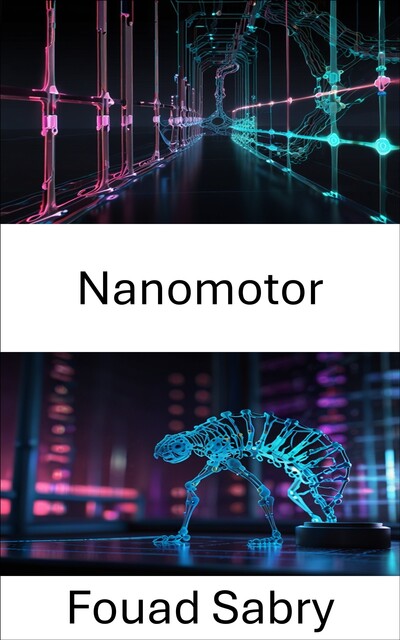We use cookies to improve the Bookmate website experience and our recommendations.
To learn more, please read our Cookie Policy.
To learn more, please read our Cookie Policy.
Accept All Cookies
Cookie Settings
Unlock the fascinating world of nanomotors with Fouad Sabry's “Nanomotor,” a comprehensive guide to the cuttingedge realm of molecular machinery. This book delves into the revolutionary technologies that drive the future of nanotechnology, offering an indepth look at how molecular motors, robots, and nanoscale devices are transforming industries. Whether you are a professional, a student, or a curious enthusiast, this book will equip you with essential insights into the exciting frontier of DNA Walker technology. With expert guidance, it explores the practical applications and futuristic potential of nanotechnology in science, engineering, and medicine. The knowledge contained within this book is an invaluable resource for understanding how molecular motors will shape the next generation of technological advancements.
Chapters Brief Overview:
1: Nanomotor: Dive into the fundamentals of molecular motors and their role in DNA Walker technology.
2: Carbon nanotube: Explore the structure and applications of carbon nanotubes in nanomotor design.
3: Nanotechnology: Gain insight into the interdisciplinary nature of nanotechnology and its widereaching implications.
4: Microbotics: Understand the fusion of nanotechnology with robotics to create functional microscopic machines.
5: Nanorobotics: Study the advances in nanorobots that can perform tasks at the molecular scale.
6: Molecular machine: Learn how molecular machines mimic biological systems for diverse applications.
7: James Tour: Discover the contributions of James Tour to the development of synthetic molecular motors.
8: Molecular motor: Examine the different types of molecular motors and their mechanisms of action.
9: Synthetic molecular motor: Explore the engineering behind synthetic molecular motors for practical use.
10: Artificial enzyme: Investigate the role of artificial enzymes in controlling molecular reactions.
11: Electroosmotic pump: Study how electroosmotic pumps move liquids at the nanoscale in microfluidic systems.
12: Micropump: Delve into micropumps and their role in nanotechnologydriven medical devices.
13: Selfpropelled particles: Understand the science behind selfpropelling particles and their application in medicine.
14: Nanoscale plasmonic motor: Learn about the innovative design and function of plasmonic motors at the nanoscale.
15: Carbon nanothread: Study the properties and potential of carbon nanothreads in nanomotor applications.
16: Tipenhanced Raman spectroscopy: Discover how this technique enhances the performance of nanomotors in diagnostics.
17: Micromotor: Examine micromotors and their applications in industrial and biomedical fields.
18: Clustering of selfpropelled particles: Analyze the behavior and implications of particle clustering in nanotechnology.
19: Collective motion: Explore how the collective motion of nanoparticles can revolutionize materials and systems.
20: Biohybrid microswimmer: Learn about biohybrid microswimmers combining biological and synthetic components for medical use.
21: Microswimmer: Study the development and application of microswimmers for targeted drug delivery and more.
With “Nanomotor,” you gain a deeper understanding of molecular machinery that powers the future of biotechnology, material science, and medicine. The book offers clear and accessible explanations, making complex topics approachable for professionals, students, and those fascinated by the emerging world of nanotechnology. Its comprehensive nature and forwardthinking content are sure to provide immense value beyond its cost, making it an essential addition to any scientific library.
Chapters Brief Overview:
1: Nanomotor: Dive into the fundamentals of molecular motors and their role in DNA Walker technology.
2: Carbon nanotube: Explore the structure and applications of carbon nanotubes in nanomotor design.
3: Nanotechnology: Gain insight into the interdisciplinary nature of nanotechnology and its widereaching implications.
4: Microbotics: Understand the fusion of nanotechnology with robotics to create functional microscopic machines.
5: Nanorobotics: Study the advances in nanorobots that can perform tasks at the molecular scale.
6: Molecular machine: Learn how molecular machines mimic biological systems for diverse applications.
7: James Tour: Discover the contributions of James Tour to the development of synthetic molecular motors.
8: Molecular motor: Examine the different types of molecular motors and their mechanisms of action.
9: Synthetic molecular motor: Explore the engineering behind synthetic molecular motors for practical use.
10: Artificial enzyme: Investigate the role of artificial enzymes in controlling molecular reactions.
11: Electroosmotic pump: Study how electroosmotic pumps move liquids at the nanoscale in microfluidic systems.
12: Micropump: Delve into micropumps and their role in nanotechnologydriven medical devices.
13: Selfpropelled particles: Understand the science behind selfpropelling particles and their application in medicine.
14: Nanoscale plasmonic motor: Learn about the innovative design and function of plasmonic motors at the nanoscale.
15: Carbon nanothread: Study the properties and potential of carbon nanothreads in nanomotor applications.
16: Tipenhanced Raman spectroscopy: Discover how this technique enhances the performance of nanomotors in diagnostics.
17: Micromotor: Examine micromotors and their applications in industrial and biomedical fields.
18: Clustering of selfpropelled particles: Analyze the behavior and implications of particle clustering in nanotechnology.
19: Collective motion: Explore how the collective motion of nanoparticles can revolutionize materials and systems.
20: Biohybrid microswimmer: Learn about biohybrid microswimmers combining biological and synthetic components for medical use.
21: Microswimmer: Study the development and application of microswimmers for targeted drug delivery and more.
With “Nanomotor,” you gain a deeper understanding of molecular machinery that powers the future of biotechnology, material science, and medicine. The book offers clear and accessible explanations, making complex topics approachable for professionals, students, and those fascinated by the emerging world of nanotechnology. Its comprehensive nature and forwardthinking content are sure to provide immense value beyond its cost, making it an essential addition to any scientific library.
more
270 printed pages
- Original publication
- 2025
- Publication year
- 2025
- Publisher
- One Billion Knowledgeable
Other versions
Have you already read it? How did you like it?
👍👎
fb2epub
Drag & drop your files
(not more than 5 at once)


